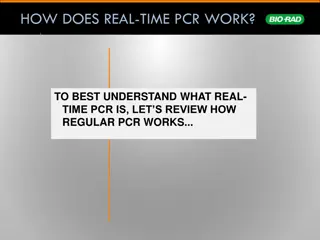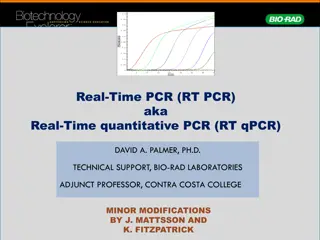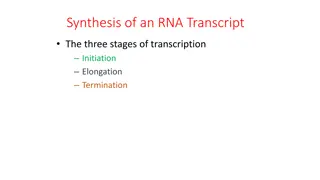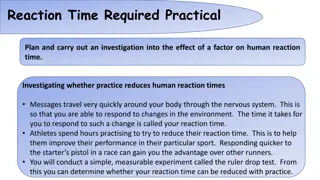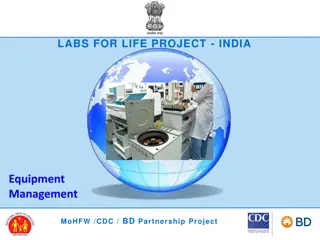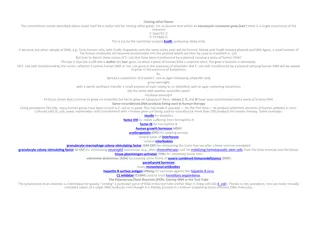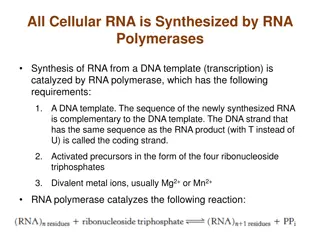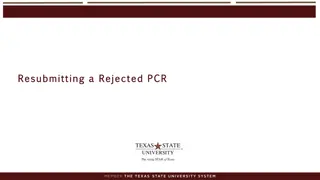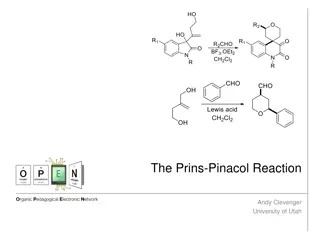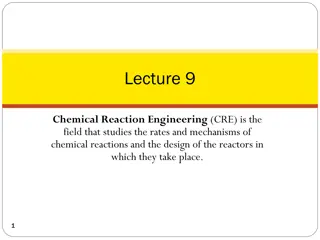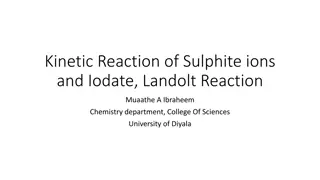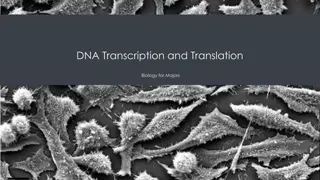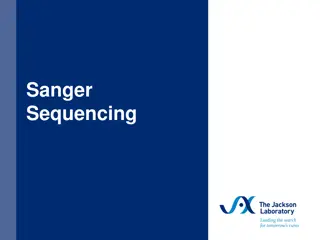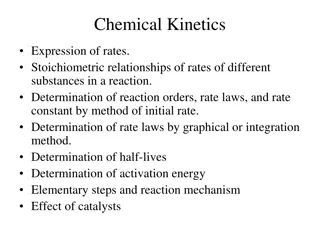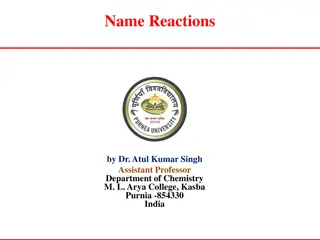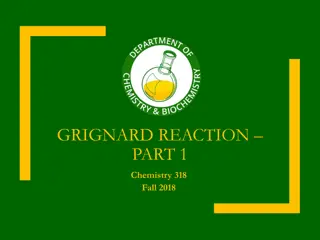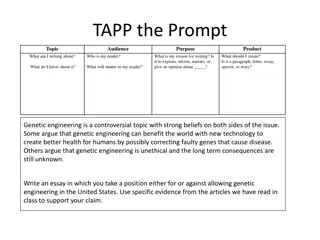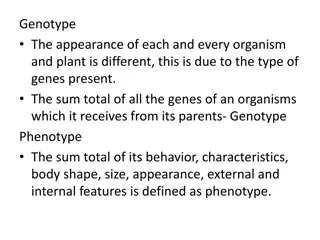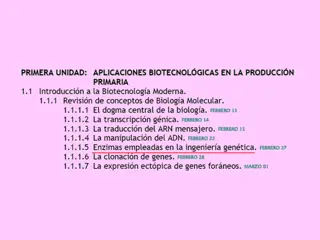Understanding Polymerase Chain Reaction (PCR) in Genetic Engineering
Polymerase Chain Reaction (PCR) is a key enzymatic method in genetic engineering developed in 1983. It amplifies targeted regions of DNA, aiding in various applications like studying diseases, forensic analysis, and analyzing ancient DNA. PCR involves heating, denaturation, primer binding, and extension cycles to produce multiple DNA copies. Key components include polymerase, template DNA, and primers. Polymerases like Taq and Pfu are crucial for DNA assembly in PCR.
Download Presentation

Please find below an Image/Link to download the presentation.
The content on the website is provided AS IS for your information and personal use only. It may not be sold, licensed, or shared on other websites without obtaining consent from the author. Download presentation by click this link. If you encounter any issues during the download, it is possible that the publisher has removed the file from their server.
E N D
Presentation Transcript
Genetic Engineering Third grade lec4
The Polymerase Chain Reaction (PCR) sometimes called (molecular photocopying) is an enzymatic method of synthesizing (amplifying) large quantities of a targeted region of DNA in vitro (extracellularly = in a test tube). Polymerase Chain Reaction (PCR) was developed in 1983 by Kary Mullis (shared Nobel Prize in Chemistry for the work in 1993). PCR machine:Also called thermal cycler.
Applications of PCR technique: 1-This technique used to study the molecular pathogenesis and diagnosis of a viral and bacterial diseases. 2- PCR can be used for forensic analysis, when only a trace amount of DNAis available as evidence. 3-PCR-based techniques have been successfully used to analyze ancient DNA (tens of thousands of years old), such as a forty-thousand-year-old mammoth.
Principles of PCR PCR, or polymerase reaction, amplifies template DNA and requires primers, polymerase, nucleotides, buffer. PCR involves heating (94- 96 C) to denature (Denaturation) into single strands, lowering the temperature to allow primer binding (Annealing) (48- 68 C), and then increasing the temperature (72-80 C) to allow the polymerase to (extension) the opposite strand to create double-stranded DNA. This process is repeated 15-40 (cycles) times to create many copies of the DNA. chain DNA and DNA synthesize
The PCR Reaction Components 1. Polymerase Polymerases are enzymes that, under the right conditions, can assemble new strands of DNA from template DNA and nucleotides. The original PCR reaction the best available DNA polymerases of the time, T4 DNA polymerase. During the essential DNA denaturation step, 94 C or 96 C for up to a minute, the DNA target was rendered single stranded. It also destroyed the polymerase each time so that fresh enzyme had to be added just after each denaturation step. However, in modern PCR this is not a problem, as the polymerases usually come from one of two thermophilic bacteria sources: 1-Thermus aquaticus (Taq) 2- Pyrococcus furiosus (Pfu) These polymerases can easily withstand the high temperatures associated with a PCR. Commercial Taq and Pfu polymerases are engineered for speed, fidelity, processivity (the ability to complete long reads), and their ability to read GC rich templates. Companies are constantly developing new polymerases. so you can decide what is best for you.
2. Template DNA This is the DNA that your polymerase will read and copy. Your template DNA can be genomic, plasmid, or cDNA. The more intact and pure template DNA, give good PCR results. The ideal amount of DNA will depend on DNA source, but it s usually 1 pg 1 ng of plasmid DNA or 1 ng 1 g of genomic DNAper PCR. 3. Primers Primers are short fragments of synthesized DNA that bind to template DNA. You will need to design one forward primer and one reverse primer. forward primer designates the start of PCR. This primer s sequence is the same as 5 -3 template DNA sequence. Reverse primer designates the end of PCR. This primer s sequence is the reverse complement of template DNA. In general, primers are 18 22 base pairs long. However, more important than their length is their melting temperature.
The melting temperatures of primers should be 5460C and as similar as possible to each other (The melting temperature of flanking primers should not differ by more than 5 C. Therefore, the GC content and length must be chosen accordingly.) If the primer is shorter than 25 nucleotides, the approx. melting temperature (Tm) is calculated using the following formula: Tm = 4(G+C) + 2(A+T) Where: G, C,A, and T, are the number of respective nucleotides in the primer. If the primer is longer than 25 nucleotides, the melting temperature should be calculated using specialized computer programs where the interactions of adjacent bases, the influence of salt concentration, etc. are evaluated. There are lots of online calculators that can work out primer annealing temperatures, and most companies that synthesize primers supply such calculators. The PCR annealing temperature (TA) should be approximately 5 C lower than the primer melting temperature.
4-Nucleotides Deoxynucleoside triphosphates (dNTPs) are necessary for making DNA copies. You can buy these separately or as a dGTP, dCTP, dATP, and dTTP mix. Note: keep in mind that nucleotides are very sensitive to freeze/thaw cycles. Therefore, it is best to create small aliquots of your dNTPs. Also, make sure that you store dNTPs properly do not use a frost-free freezer that goes through automatic defrost cycles. 5. Buffer Most commercial polymerases come supplied with their ideal buffer. These buffers not only supply the correct pH, but always have additives like magnesium, potassium, or DMSO, which help optimize DNA denaturing, renaturing, and polymerase activity.
PCR Steps PCR is a three-step process which is repeated in several cycles. Each synthesis cycle is composed mainly of three steps: Denaturation , PrimerAnnealing & Extension 1- Initialization In this step, the reaction is heated to 94 96 C for 30 seconds to several minutes. This step is usually done only once at the very beginning of PCR reaction. This step is important for activating hot-start polymerases, and for denaturing template DNA. Note: If your template GC content is high, you may need to perform an extralong initialization step. 2- Denaturation (Repeated 15 40 Times) In this step, the reaction is heated to 94 96 C for 15 30 seconds. This step denatures your DNA and primers, which will allow them to anneal to each other in the next step.
3. Annealing (Repeated 1540 Times) In this step, the reaction s temperature is rapidly lowered to 48 68 C for 20 40 seconds. The temperature in this step needs to be low enough that denatured primers can bind with template DNA, but high enough that only the most stable (perfectly paired) double-stranded DNA structures can form. Also during this step, polymerase will bind to primer/template DNA complex, although polymerase will not start reading until the temperature is raised in the next step.
4- Elongation or Extension (Repeated 1540 Times) In this step, the reaction is rapidly heated to 72 80 C. So polymerase will begin copying template. The higher temperature during this step reduces non-specific primer/template DNA interactions, thus increasing the specificity of the reaction. The length of this step depends on how long your DNA copy will be. Typically, DNA polymerase can copy 1000 base pairs per minute. Therefore, you need to allow at least 1 minute of extension time per 1000 bases. At the end of this step, new double-stranded pieces of DNA will have been created, consisting of both template and new DNA. Not : Steps 2 4 are then repeated 15 40 times: It is true that the more cycles you program, the more DNA copies you will create. However, there is an upper limit. At some point available free nucleotides become limiting and prematurely truncated DNA copies can become a problem. So don t get greedy with your cycling. Less product that is good and clean is preferable to lots of dirty product.
5-Final Elongation This is an optional but often recommended step in the PCR process. In this step, the reaction is held at 70 74 C for several minutes. (Usually, you will use the same temperature as you used in the Elongation or Extension step.) This step allows the polymerases to finish reading whatever strand they are currently on. This optional step can help reduce the number of truncated copies in the final product. 6- Final Hold The reaction is now complete. It is recommended that you program the thermocycler to hold PCR product at 4 C until using. You can then analyze or use the product, or transfer it to more suitable long-term storage like refrigerator.
Amplifying GC-rich regions of DNA: GC-rich sequences are more difficult to amplify for these reasons:- Firstly, GC rich , mean approximately 60% of the bases are either cytosine (C) or guanine (G). GC-rich DNA sequences are inherently more stable than sequences with a low GC content. For PCR, this means that the higher the GC content, the higher the melting point of the DNA. This is why Thermus thermophilus, an extremophile that needs to tolerate very high environmental temperatures, has a GC-rich genome. This is also why regions of our genome that need to be transcribed very often such as promoter regions of highly expressed genes, areAT-rich, like the TATAbox. This GC-rich regions can form secondary structures, particularly hairpin loops, these secondary structures don t melt well at usual PCR denaturation temperatures. 3-Additionally, primers used to amplify GC-rich regions tend to form self- and cross-dimers as well as stem- loop (or hairpin) structures that can impede the progress of the DNA polymerase along the template molecule leading to truncated PCR products. 4-GC-rich sequences at the 3 end of primers can also lead to mispriming.
A more recent modification of the PCR amplification is the real-time PCR, or quantitative PCR (qPCR), since it employs fluorescent dyes to monitor the amplification process in real time. There are many different versions of qPCR, either using a fluorescent DNA dye such as SYBR Green, which binds stranded DNA (it is nonspecific), or using gene-specific probes that are fluorescently labeled. The principle of qPCR is that since the fluorescent dye binds to double-stranded DNA, as the amount of DNA doubles up at each cycle (2n), the amount of fluorescence is doubled, which can be measured automatically at the end of each cycle. to double-



